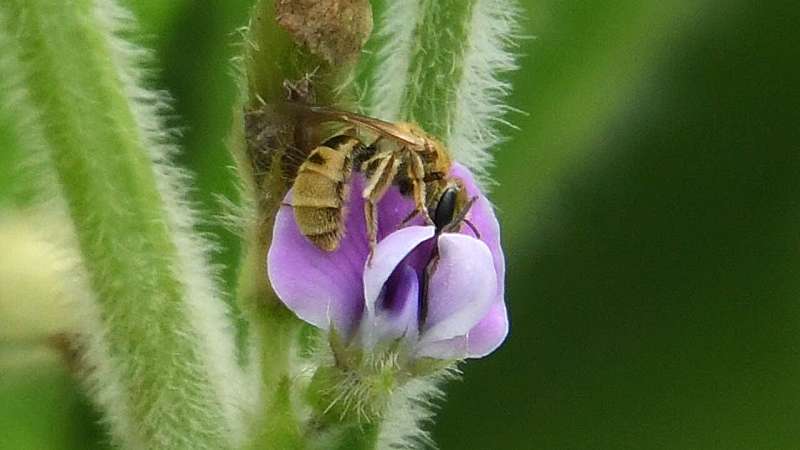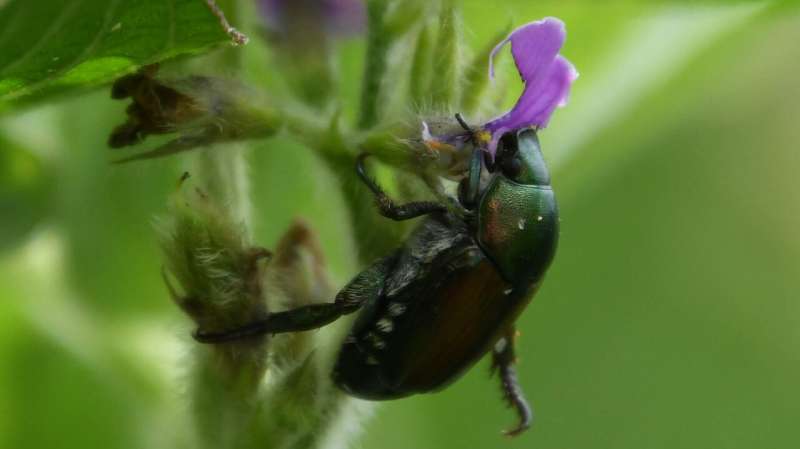This article has been reviewed according to Science X's editorial process and policies. Editors have highlighted the following attributes while ensuring the content's credibility:
fact-checked
trusted source
proofread
Pollinators found to make a big impact on edamame marketability

Soybeans can pollinate themselves, but a new study by UMD researchers shows that pollen from multiple plants can greatly increase their yields. What's more, the addition of a strip of wildflowers near rows of soybeans amplifies the effect. The information could help farmers of one of Maryland's top commodities increase the production and marketability of their crops.
The research was published in the Journal of Pollination Ecology.
Soybeans represent an important crop in the U.S., but scientists don't completely understand their pollination and reproduction strategies.
"Our study has shown that cross-pollination is important for improving soybean production and suggests that increases of biodiversity near edamame fields can affect production in market-relevant ways," said Kathleen Evans, lead author on the paper and a graduate student in the Department of Entomology at the University of Maryland.
The researchers focused their study on edamame, which is the same species of soybean grown in the U.S. for animal feed but harvested earlier for human consumption. That means the study's findings are applicable to both edamame and feed soy, but understanding how pollination strategies affect the size and quality of soybeans is especially important for the growing edamame market, where consumer acceptance and the number of seeds per pod are important for sales.
Although soybeans are globally cultivated, no formal tests had previously evaluated whether flowers receiving their own pollen (self-pollination) or a different soybean flower (cross-pollination) affect bean pod quality.

To answer that question, Evans and her colleagues used three different methods to pollinate soy plants in a 16 x 16-meter experimental plot at the University of Maryland Central Maryland Research and Education Center (CMREC) in Beltsville, MD. They also planted a strip of wildflowers native to the Mid-Atlantic region along one end of the plot.
The researchers covered the flowers of some plants with a fine mesh that prevented pollinators from visiting. Those flowers would be self-pollinated. They also carefully pollinated a second group of flowers by hand with pollen from a separate donor plant. A third group of flowers was left open and untreated to be pollinated naturally, which means they were likely cross-pollinated by insects.
The researchers found that compared to self-pollination, hand cross-pollination, and open-pollination led to more market grade-A quality pods, but open-pollinated flowers had more grade-A beans than either of the other two treatments. In addition, the harvest from plants that had been left open was 17% heavier than self-pollinated and hand-pollinated plants.
They also found that open-pollinated soybean plants grown closer to flower strips had greater yield. The researchers believe more pollinators and/or predators of pests may have visited those soybean plants on their way to or from the wildflowers, suggesting that greater biodiversity near and in the fields could increase yields in this crop.
More information: Kathleen Evans et al, Benefits of Cross-Pollination in Vegetable Soybean Edamame, Journal of Pollination Ecology (2023). DOI: 10.26786/1920-7603(2023)728
Provided by University of Maryland




















